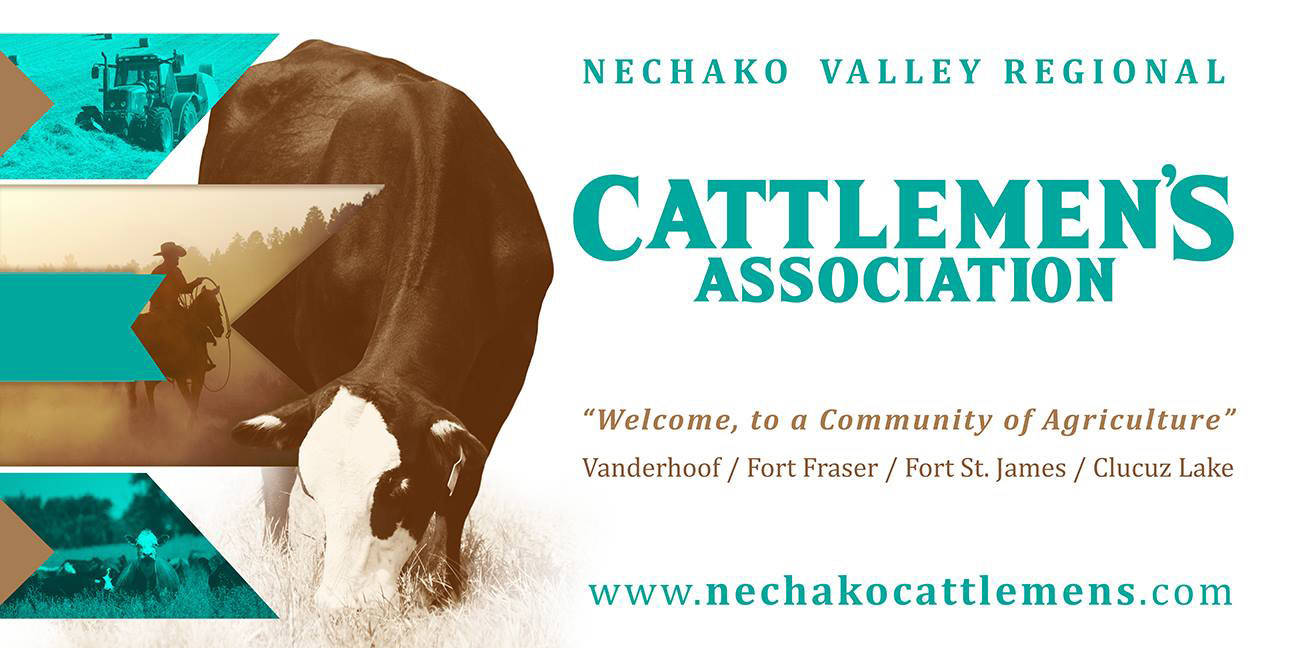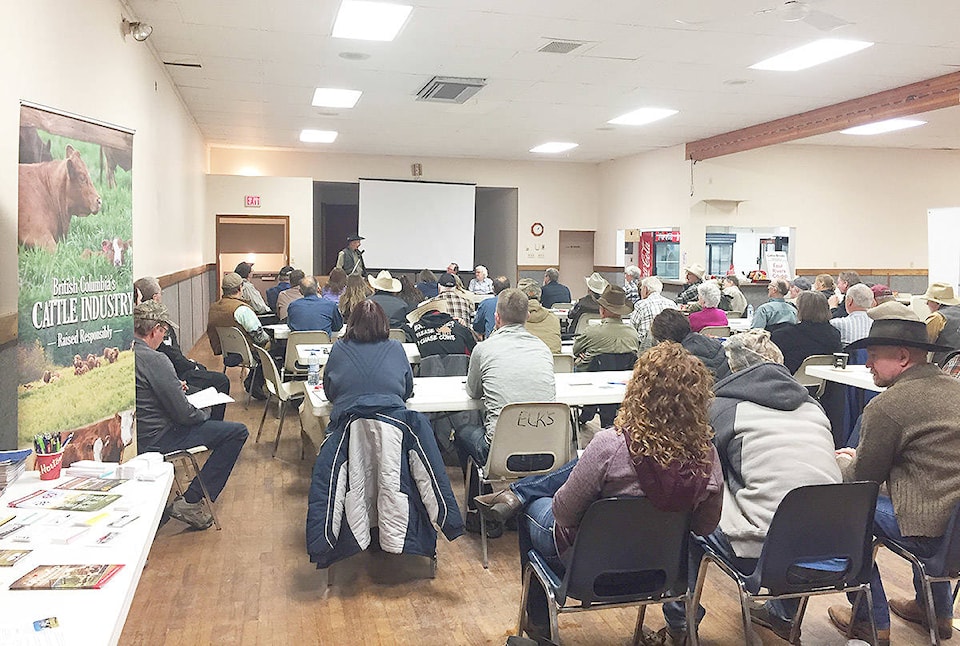The Nechako Valley Regional Cattlemen’s Association (NVRCA) is working to get the message out to the public about their beef-producing passion and livelihood. The NVRCA now have a website www.nechakocattlemens.com, a resource for members, but also an education tool sharing facts like our beef industry in the Nechako Valley and surrounding area is the second largest industry behind forestry.
Depending on market fluctuations, beef sales of about $30 - 40 million per year go through the B.C. Livestock Sale Yard in Vanderhoof. The volume of animals sold per year is always close to 21,000 calves and yearlings, 3,000 cows and 500 bulls, but prices vary. On a high value year, like 2015, ranchers are able to reinvest in their operations, and wherever they can they buy local because they truly understand the impact.
“With profitability back in the family beef operations, many local businesses are benefiting,” says Liz Legebokoff, Public Relations Committee, as she indicates on their website; “Fertilizer sales, equipment sales, parts sales, lumber sales, fuel sales, etc. are all on the rise. With those sales increases come jobs to the community.”
It must be recognised that beef producers and their families make a significant contribution to the social and economic well-being of the Nechako Valley and have done so for many years.
“We are not tied to a tree!” says John Kotchel, Association President. His humorous words are quite serious at the same time; these ranchers intentionally find the time outside work demands to support local activities such as youth and sports groups, church events, charities, schools and more, making the community is more vibrant and resilient as a result.
Highlights, new initiatives
Many beef industry stakeholders attended the 2018 Nechako Valley Regional Cattlemen’s Association AGM held at the Elks Hall in Vanderhoof this past Sat. Feb. 24. It was well attended with about 150 people coming through the door for the meeting and trade show. One hundred and twenty tickets were sold for the dinner afterwards with internationally acclaimed keynote speaker Bruce Vincent.
Highlights from the AGM were reports from BC Cattlemen’s Association Vice President, Larry Garrett and Committee reports on Aboriginal Affairs & Land, Livestock Industry Protection, Public Relations, and Research. Discussion topics included the devastating alfalfa crop loss last spring; fencing replacement and fire break reseeding after last summer’s wildfires; changes to antibiotics regulations, tag scanning, and a three year pilot Predator Protection program. The grizzly population is reportedly increasing and notable losses continue to be recorded from wolves and raven attacks. Members were introduced to Conservation Officers Sgt. Steve Ackles and Cpl. James (Jay) Brady who are based in Prince George but help Cpl. Amber Elliot with the workload here as well.
In other Association news, a request has been put to the Minister of Transportation for farm equipment awareness signage on highway 16 and there will be two 8’ x 16’ marketing billboards going up, one either side of Vanderhoof. Even though the Financial report shows a budget surplus carried over into the current fiscal year, there is still Association interest in a revenue generating Community Forest and membership dues will be increasing to help cover costs and new initiatives like student scholarships the Association is awarding.
Local guest speakers included Vanderhoof Mayor, Gerry Thiessen; Mark Parker and Regional District of Bulkey Nechako (RDBN). Debbie Evans, RDBN Agriculture Coordinator, spoke enthusiastically about her two year pilot project funded by Northern Development Initiative Trust. Evans is promoting the Emergency Preparedness program and engaging all producers in the area, working to craft supports for the region’s farmers and ranchers. One project Debbie Evans and Brad McRobert, BC Regional Economic Development Manager, will be working on is helping the Shavings Committee. They have been working hard lobbying for support from government officials to secure a contract for the increasing demand for wood shavings supply from area sawmills. Wood shavings is the animal bedding material of choice, a superior, healthier alternative to straw. The current contract is up for renewal in August this year and securing an economical, long term supply is critical for ranching industry operations.
Further on the AGM agenda, Janice Tapp led new business items relating to the constitution and received written resolutions from different chapters which were then voted on by members. Last year the BC Cattlemen’s Association announced that Trevor and Janice Tapp of Copper-T Ranch were the recipients of the 2017 Ranch Sustainability Award.
Canadian Agriculture Partnership
Ministry of Agriculture representative, Lavonna Liggins, made some important announcements about changes to government funding for farmers. She said that the Growing Forward 2 program is now replaced by the Canadian Agriculture Partnership (CAP) funding, “a five-year, $3 billion investment by federal, provincial and territorial governments to strengthen the agriculture and agri-food sector.” The new CAP fund features “simplified and streamlined programs and services that are easier to access, as well as key enhancements to programs that help farmers manage significant risks that threaten the viability of their farm and are beyond their capacity to manage.”
Agricultural activism
Vincent’s presentation was titled “So you want to date my daughter.” He spoke about the urban public majority owning the social license when it comes to natural resource protection and sustainability. The challenge facing producers is that there is a booming “conflict industry” spreading misinformation to consumers about the environmental harms of logging and farming.
Vincent says, “If the public wants red meat on their table, they should want it to come from Vanderhoof,” the agriculture industry is the conflict industry’s “new piñata” and producers, or anyone involved with animals and water, need to do a better job at telling the public their story of sustainable practices so that consumers can trust where their food is coming from.
“When people lead, leaders follow” so producers need to identify the challenges they face and craft the solutions they need (to protect our values) and hand it to your leaders,” continues Vincent, and being engaged in democracy and local politics is essential. “Democracy does work, but we need to support the leaders we support.”
Engage in local politics
The speaker advised farmers and ranchers “Add a line item to your business plan. Advocating and activism should be part of doing business. Activism isn’t marching in the street. Activism is taking an hour a week to go to one of the meetings identified as opportunities to build ideas. It is being engaged in this Association and one of its committees to develop a resolution, it’s going to one of your [elected officials] and talking to them.” Vincent explained that if beef industry advocates don’t give politicians the solutions that will work, they’ll find a solution that doesn’t work.
“If we all do that there’s a reason to have hope. This is the message that is going to maintain your social license,” adds Vincent.
“The world is run by those who show up. There are a lot of opportunities to show up and make a difference. If we’re going to survive we’re going to have to become activists,” concluded Vincent.

